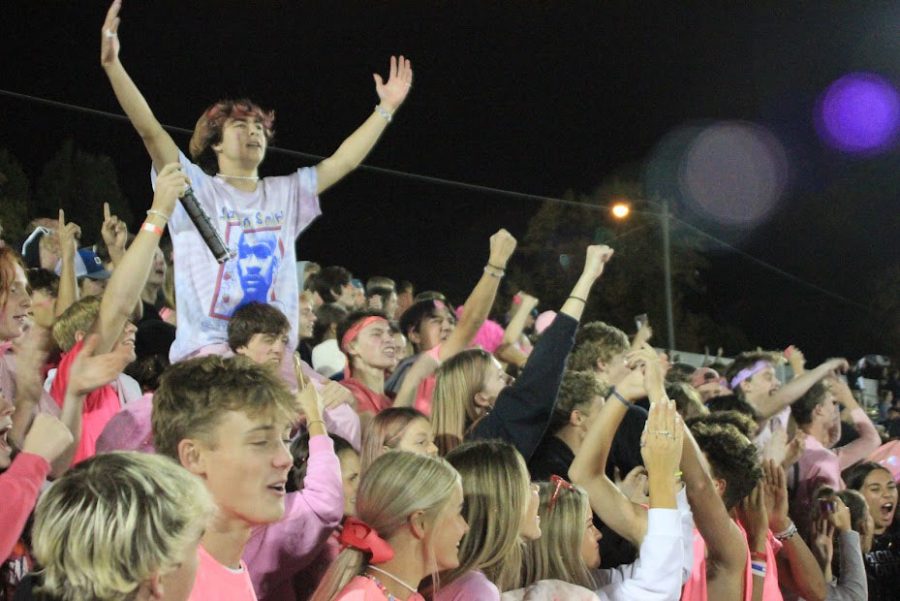The World For Teens Has Changed Dramatically Over Generations
Highland students cheer for the football team during a game at Olympus earlier this season.
November 15, 2021
“Devious licks” is not a phrase any parent of a Highland student had ever heard before they had teenagers of their own.
Thanks to Tik-Tok and other social media platforms, parents are stressed about their kids breaking the law and students are being entertained and, at times, influenced by the posts of complete strangers.
Welcome to being a teenager in the year 2021.
“The Highland Rambler” will be focusing a special section each issue on the unique challenges, opportunities, and experiences that being a teenager in today’s world brings…while also looking back at what parents and grandparents experienced when they were in adolescence.
Every generation has its unique defining qualities. For this generation, the rise of individuality, which has been influenced by cell phones and social media, is something those who came before can’t help but notice…both the good and bad of it all.
This school has been around longer than most of its students’ parents. During that time, the world has altered dramatically. Not only have the roads around Highland gotten busier, the cars faster, the city crazier, but the students inside have changed. Naturally it’s to be expected that as the world grows, ways of life develop and change; but specifically, the experience of being a teenager has always been impossible to predict.
The teenage years, of course, have eternally existed as a stage of human life. However, it was not until the early 20th Century that the idea of adolescence as a distinct developmental phase emerged. This was driven by three main factors, as mentioned in an article by Derek Thompson for the “Saturday Evening Post:” the increased time spent at school, the availability of personal cars, and a booming postwar economy.
Combined, these factors made it exponentially more possible for young people to develop a life and a social circle away from their parents. This gradually led to today’s situation in which teenagers are a main driving point in pop culture, fashion, and brand advertising.
One idea about adolescents, which has been around literally since the time of Socrates, is that they are out of control and bound to create trouble. Because the brain’s pre-frontal cortex does not develop fully until adulthood, teenagers are more likely to participate in risk-taking and impulsive behavior.
This is accurate, and teenagers are also more likely to challenge authority and try to set themselves out as independent. Though this has always been the case, Highland teacher Collette Cornwall has noticed that high schoolers now are bolder and more confrontational than they were when she attended Skyline in the early 1970s.
“Nobody every argued with a teacher,” Cornwall said.
The fact that students now are more likely to challenge their teachers’ authority now sounds like a bad thing, and in many cases it definitely can be. But Cornwall also explained the perspective that students are now likely to engage with their teachers and ask questions when they are confused, rather than being too intimidated to speak up.
This less-fearful attitude also helps students feel more courageous in expressing themselves, Cornwall said, specifically when it comes to their identities.
“When I was in school, everybody wanted to look the same, and we had a lot more cliques,” Cornwall said.
Now, she says, everyone is more open to socializing with different types of people and embracing diversity.
However, one of the main negative impacts spoken to by both Cornwall and Tosha Myers, another Highland teacher, is the rise of cell phones and social media.
“Working in a high school, it seems pretty similar to when I was in high school 10 years ago, besides phones,” Myers said.
She thinks that it’s nice that people can be more connected now, and it’s easier to stay in touch with people who live far away, but she has noticed several negative mental health impacts from social media.
Myers is also concerned about the abundance of information available instantly on a cell phone. She said that kids get into trouble as much now as they used to, but in today’s environment, the difference is that everyone knows about it from a video taken on a phone.
Cornwall, as well, is concerned about the number of expectations placed on teenagers in the digital age.
“I think there is a lot of pressure on kids now, and I’m worried about all the things you’re expected to do,” Cornwall explained, referring to the number of classes, sports, and extracurriculars taken on by many students.
Her main message to share with today’s high schoolers is that the world is tough, but that they need to work on being able to overlook some of the pressure put on them and make their lives into something meaningful, and not solely for the purpose of being Instagram-worthy.
“It’s important to start sorting out what’s important to you, and it’s important to pursue some opportunities but you don’t have to do everything,” Cornwall emphasized.
This is a message that many kids can take to heart in this world where everything we do is shared and compared. Though life is very different from what it was just a few generations ago, most teenagers have very dynamic and malleable personalities, allowing them to adapt to any current situation and thrive regardless.
It makes one wonder about what people will be saying about the next generation and its problems.




























